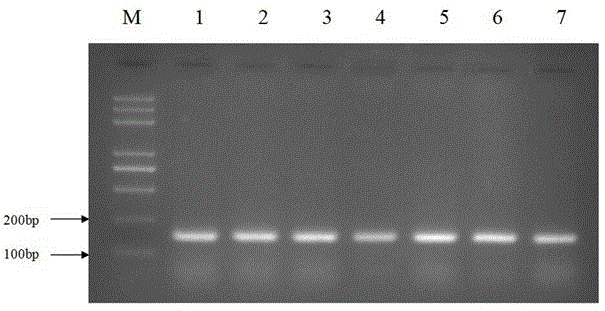Method for rapidly extracting DNA of single sporangium of phytophythora infestans
A technology of potato late blight and sporangia, which is applied in the biological field, can solve the problems of increased pollution, cumbersome, difficult to master, etc., and achieves the effect of reducing loss and efficient extraction
- Summary
- Abstract
- Description
- Claims
- Application Information
AI Technical Summary
Problems solved by technology
Method used
Image
Examples
Embodiment 1
[0018] 1. Isolation of individual sporangia
[0019] Use a sterile inoculation needle to pick a mycelium mass of Phytophthora infestans with a diameter of about 4mm from the edge of the lesion on the diseased leaf, put it in a 25mL centrifuge tube, add 7mL of sterile water and mix well, then filter with sterilized absorbent cotton to collect the spores The capsule suspension is placed in a 2ml centrifuge tube, and the next step should be carried out immediately to avoid the release of zoospores.
[0020] Adjust the concentration of the sporangia suspension to 1 / 2 μL, use a capillary glass tube with a diameter of 6 mm to self-absorb for 8 seconds, draw 2 μL of the suspension, observe it under a microscope, and transfer it to a 0.5 mL centrifuge tube after confirming that it contains a sporangia. Place in a refrigerator at 4°C for 2 hours to fully release the zoospores in the sporangia.
[0021] 2. Extraction of DNA from individual sporangia
[0022] Improve the CTAB method ...
Embodiment 2
[0029] 1) Isolation of single sporangia
[0030] a. Use a sterile inoculation needle to pick a mycelium mass of Phytophthora infestans with a diameter of about 4mm in a 25mL centrifuge tube at the edge of the diseased leaf lesion, add 10mL of sterile water and mix well, then use sterilized absorbent cotton to filter, Collect the sporangia suspension in a 2ml centrifuge tube and proceed to the next step immediately to avoid the release of zoospores.
[0031] b. Adjust the concentration of the sporangia suspension to 1 / 2 μL, use a capillary glass tube with a diameter of 6 mm to self-absorb for 7 seconds, draw 2 μL of the suspension, observe under a microscope, and transfer it to a 0.5 mL centrifuge tube after confirming that it contains a sporangia. Place in a refrigerator at 4°C for 2 hours to fully release the zoospores in the sporangia.
[0032] 2) Extraction of single sporangia DNA
[0033] Improve the CTAB method to extract the DNA of a single sporangia, the main steps ar...
Embodiment 3
[0039] 1) Isolation of single sporangia
[0040] a. Use a sterile inoculation needle to pick a mycelial mass of P. infestans with a diameter of about 4mm in a 25mL triangular flask at the edge of the diseased leaf lesion, add 5mL of sterile water and mix well, then filter with sterilized absorbent cotton, Collect the sporangia suspension in a 2ml centrifuge tube and proceed to the next step immediately to avoid the release of zoospores.
[0041] b. Adjust the concentration of the sporangia suspension to 1 / 2 μL, use a capillary glass tube with a diameter of 6 mm to self-absorb for 6 seconds, draw 2 μL of the suspension, observe under a microscope, and transfer it to a 0.5 mL centrifuge tube after confirming that it contains a sporangia. Place in a refrigerator at 4°C for 2 hours to fully release the zoospores in the sporangia.
[0042] 2) Extraction of single sporangia DNA
[0043] Improve the CTAB method to extract the DNA of a single sporangia, the main steps are as follows...
PUM
 Login to View More
Login to View More Abstract
Description
Claims
Application Information
 Login to View More
Login to View More - R&D
- Intellectual Property
- Life Sciences
- Materials
- Tech Scout
- Unparalleled Data Quality
- Higher Quality Content
- 60% Fewer Hallucinations
Browse by: Latest US Patents, China's latest patents, Technical Efficacy Thesaurus, Application Domain, Technology Topic, Popular Technical Reports.
© 2025 PatSnap. All rights reserved.Legal|Privacy policy|Modern Slavery Act Transparency Statement|Sitemap|About US| Contact US: help@patsnap.com



